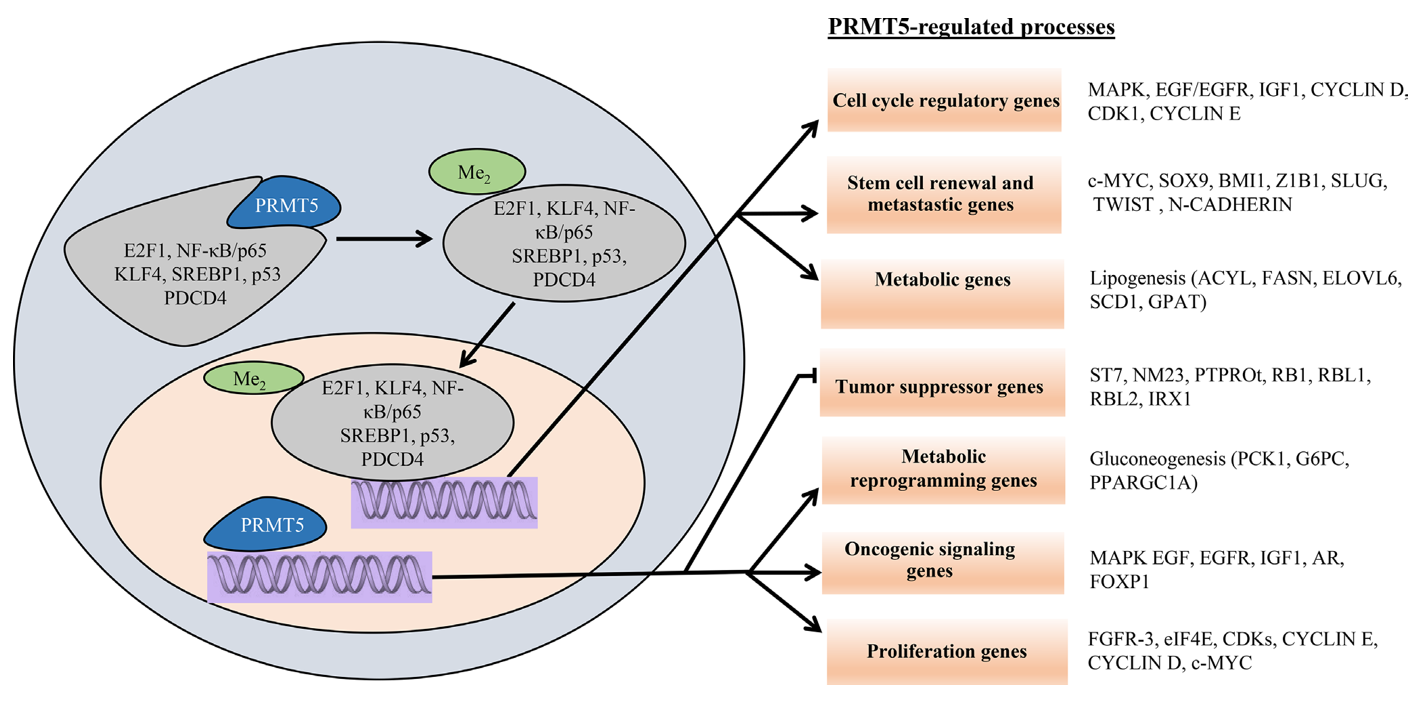
Our promise to you:
Guaranteed product quality, expert customer support.
 24x7 CUSTOMER SERVICE
24x7 CUSTOMER SERVICE
 CONTACT US TO ORDER
CONTACT US TO ORDER
PRMT5 Gene Editing 
Protein arginine methyltransferase 5 (PRMT5), a member of the PRMT family of proteins, plays a key role in regulation of cellular signaling and gene expression by covalently modifying (methylating) histones as well as nonhistone proteins. PRMT5 catalyzes the symmetric dimethylation of guanidine nitrogen atoms in the arginine residues of its substrate. Dimethylation of histone proteins H3 (S2Me-H3R8), H4 (S2Me-H4R3), and H2A directed by it regulates chromatin structure to promote transcriptional repression. The C-terminus of PRMT5 contains domains (I, II, III, and post-I), which are typical of S-adenosyl-L-methionine (SAM)-binding proteins. Importantly, mutations in the SAM-binding domain motif I (GXGRGP) of PRMT5 have been shown to significantly reduce its catalytic activity. The C-terminal domain also interacts with the N-terminal domain, which is necessary for the formation of functional homo-oligomeric complexes.
PRMT5 and Cancer
Numerous studies have documented PRMT5 overexpression in cancers of different types and aggressiveness including B and T cell lymphoma, breast cancer, colorectal cancer, neuroblastoma and glioblastoma, germ cell tumors, metastatic melanoma, ovarian cancer, nasopharyngeal cancer, and gastric cancer. Since genetic alterations (amplification, mutation, deletion) are rare in PRMT5 genes, epigenetic control of PRMT5 in cancer has become a key player in the control of its expression and activity. Studies in the past decade have clearly shown that enhanced PRMT5 expression in cancer cells is related to transcriptional silencing of its target tumor suppressor genes. One of the main growth regulatory pathways controlled by PRMT5 is the highly conserved RB-E2F pathway. PRMT5 regulates this pathway through direct methylation of histones H3R8 and H4R3 in the promoter region of RB1, RBL1 and RBL2 tumor suppressor genes. The final result of these modifications is transcriptional repression of all three tumor suppressor genes; however, only RBL2 was inhibited at the protein level. Although RB1 and RBL1 are not suppressed translationally, they are both inactivated by hyperphosphorylation by the CYCLIN D-CDK4/6 kinase complex.
 Figure 1. Schematic model of PRMT5-regulated cellular processes. (Shailesh H, et al., 2018)
Figure 1. Schematic model of PRMT5-regulated cellular processes. (Shailesh H, et al., 2018)
PRMT5 is related to the reprogramming of lipogenesis in cancer cells, and in modulation of the G1 to S phase checkpoint under high glucose concentration. The gene expression program responsible for biosynthesis of fatty acids, triglycerides, and phospholipids is strictly controlled by the transcription factors, sterol regulatory element-binding protein (SREBP) 1a and c. Both transcription factors have been shown to interact with PRMT5 in HepG2 and HEK293 cell lines, highlighting the relevance of this association in increased lipogenesis of cancer cells. In addition, dependence on the PRMT5 catalytic activity for this interaction suggests that, in fact, PRMT5 symmetrically methylates SREBP1a on R321, which prevents its phosphorylation on serine 430 by GSK3β and increases its transcriptional activity, thereby enhancing lipogenesis in hepatocellular carcinoma.
Therapeutic Interventions Based on PRMT5
Since PRMT5 is involved in a wide range of physiological processes, crucial for maintenance of cancer phenotypes, perturbation of PRMT5 is expected to provide a new method for cancer treatment. Along these lines, PRMT5 plays an important role in embryonic stem and tissue specific stem/precursor cells, and accordingly, PRMT5 contributes to the self-renewal of cancer stem cells (CSCs). This is exemplified by the activation of FOXP1 transcription in breast cancer stem cells and DVL3 transcription, an activator of Wnt/β-catenin, in CML-LSCs (leukemic stem cells), which were associated with PRMT5 activity. Given the key roles of CSCs in drug-resistance and relapse, PRMT5 inhibition may provide a new therapeutic modality for cancer-initiating cells. Emerging evidence suggests that disruption of splicing fidelity by PRMT5 depletion/inhibition may have an anti-cancer effect. To support this view, the presence of a frequently occurring splicing factor (SF) mutation (SRSF2P95H) or treatment with an SF3B1 inhibitor renders AML cells vulnerable to PRMT5 and/or PRMT1 inhibition. Similarly, combinatorial inhibition of type I and type II PRMTs leads to an enhanced therapeutic effect by increasing aberrant spliced targets seen upon inhibition of both PRMTs.
PRMT5 Gene Editing Services
CRISPR/Cas9 PlatformCB, one of the leading biotechnological companies specializing in gene editing, is dedicated to offering comprehensive CRISPR/Cas9 gene-editing services to a wide range of genomics researchers. Based on our platform, we can help you effectively PRMT5 gene deleted, inserted or point mutated in cells or animals by CRISPR/Cas9 technology.
- PRMT5 Gene Knockout: We offer PRMT5 gene knockout cell line and knockout animal model generation service with high quality. Typically, we develop CRISPR-mediated gene editing cell lines including HEK239T, Hela, HepG2, U87, but we can use other cell lines according to your requirements. Our one-stop KO animal model generation service covers from sgRNA design and construction, pronuclear microinjection to Founders genotyping and breeding.
- PRMT5 Gene Knockin: CRISPR/Cas9 PlatformCB provides the one-stop PRMT5 knock-in cell line and knockout animal model generation services, including point mutation and gene insertion. Our expert staff has succeeded in dozens of PRMT5 knock-in cell line generation projects, including stem cells, tumor cells and even difficult-to-handle cells. We also have extensive experience in incorporating CRISPR/Cas9 technology into animal models, which have been fully recognized by our clients.
If you have any questions, please feel free to contact us.
Related Products at CRISPR/Cas9 PlatformCB
| CATALOG NO. | PRODUCT NAME | PRODUCT TYPE | INQUIRY |
| CCKM1145 | B6J-Prmt5em2Cd123 | Knockout Mouse | Inquiry |
References
- Stopa N, et al. The PRMT5 arginine methyltransferase: many roles in development, cancer and beyond. Cellular and molecular life sciences, 2015, 72(11): 2041-2059.
- Koh C M, et al. The Where and the How of PRMT5. Current Molecular Biology Reports, 2015, 1(1): 19-28.
- Shailesh H, et al. Protein arginine methyltransferase 5 (PRMT5) dysregulation in cancer. Oncotarget, 2018, 9(94): 36705.
- Kim H, Ze'ev A R. PRMT5 function and targeting in cancer. Cell Stress, 2020, 4(8): 199.
- Banasavadi-Siddegowda Y K, et al. PRMT5 as a druggable target for glioblastoma therapy. Neuro-oncology, 2018, 20(6): 753-763.